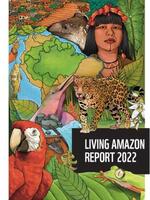The dawn chorus of birds singing, monkeys howling, frogs calling and insects buzzing. The crystal clear waterfalls that are perfect for a refreshing afternoon swim. Fireflies illuminating trees at night.
The beauty and tranquility of forests all over the world—from the tropics to the tundra—inspire all of us. We know forests are home to most of the world’s life on land. More than 3 billion people—75% of all people outside urban areas—live within 1 kilometer of a forest, too. And more than one-third of the world’s population has a close dependence on forests and forest products.
But threats to the world’s forests are growing. Expanding agriculture, due to an increased population and shifts in diet, is responsible for most of the world’s deforestation. Illegal and unsustainable logging, usually resulting from the demand for cheap wood and paper, is responsible for most of the degradation of the world’s forests—the largest threat to the world’s forests. In degraded forests, small trees, bushes and plants often are severely damaged or dead; rivers are polluted; slopes are eroded; and more.
The threats are so severe that we are losing huge swathes of forests at an alarming rate. The Amazon, the planet’s largest rain forest, lost approximately 17% of its forest cover in the last half century due to human activity—mainly clearing trees to create new or larger farms and ranches.
WWF is working to address the threats to forests: By 2030, we must conserve the world’s forests to sustain nature’s diversity, benefit our climate and support human well-being.
Most of WWF’s work is being done in tropical rain forests, which are the most biologically diverse and complex forests on Earth—forests in the Amazon, the Congo Basin, the Greater Mekong and other regions near the equator. But it also is taking place in temperate regions, such as the Russian Far East and the United States.


 Sustainability Works
Join WWF at GreenBiz23
Sustainability Works
Join WWF at GreenBiz23
 Sustainability Works
Bringing Tools to Bear for Biodiversity
Sustainability Works
Bringing Tools to Bear for Biodiversity




 Kerry Cesareo
Senior Vice President, Forests
Kerry Cesareo
Senior Vice President, Forests
 Linda K. Walker
Senior Director, Corporate Engagement, Forests
Linda K. Walker
Senior Director, Corporate Engagement, Forests
 Colby Loucks
Vice President, Wildlife Conservation Program
Colby Loucks
Vice President, Wildlife Conservation Program
 Meg Symington
Managing Director, Amazon
Meg Symington
Managing Director, Amazon
 Kate Newman
Vice President, Sustainable Infrastructure and Public Sector Initiatives
Kate Newman
Vice President, Sustainable Infrastructure and Public Sector Initiatives
 Amy Smith
Director, Sustainable Natural Rubber, Forests
Amy Smith
Director, Sustainable Natural Rubber, Forests
 Erin Simon
Vice President and Head, Plastic Waste and Business
Erin Simon
Vice President and Head, Plastic Waste and Business
 Josefina Braña Varela
Vice President and Deputy Lead, Forests
Josefina Braña Varela
Vice President and Deputy Lead, Forests
 Lloyd Gamble
Director, Forests and Climate
Lloyd Gamble
Director, Forests and Climate
 Christopher Holtz
Vice President, Earth for Life
Christopher Holtz
Vice President, Earth for Life
 Pablo Pacheco
Global Forests Lead Scientist, Global Science
Pablo Pacheco
Global Forests Lead Scientist, Global Science
 Stephanie Cappa
Director, Policy and Government Affairs
Stephanie Cappa
Director, Policy and Government Affairs
 Naikoa Aguilar-Amuchastegui
Director, Forest Carbon Science
Naikoa Aguilar-Amuchastegui
Director, Forest Carbon Science
 Dechen Dorji
Senior Director for Asia, Wildlife Conservation
Dechen Dorji
Senior Director for Asia, Wildlife Conservation
 Craig Beatty
Manager, Forest Strategy and Research
Craig Beatty
Manager, Forest Strategy and Research
 Katie Zdilla
Director, Earth for Life
Katie Zdilla
Director, Earth for Life
 Amelia Meadows
Manager, Forests
Amelia Meadows
Manager, Forests